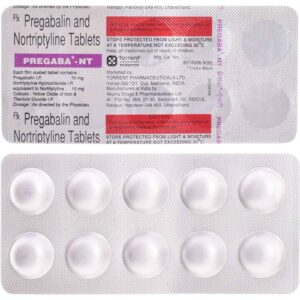NORTRIPTYLINE + PREGABALIN
Nortriptyline: Nortriptyline is a tricyclic antidepressant that is primarily used to treat depression. It is also sometimes prescribed to manage chronic pain, such as migraines or neuropathic pain.
The exact mechanism of action for nortriptyline is not fully understood. However, it is thought to work by increasing the levels of certain neurotransmitters in the brain, such as serotonin and norepinephrine. This increase in neurotransmitter levels helps to improve mood and reduce depressive symptoms.
The typical starting dose of nortriptyline for depression is usually 25 mg taken orally once daily at bedtime. The dosage can then be gradually increased over time based on the individual’s response and tolerance. The maximum recommended dose is typically 150 mg per day, although some individuals may require higher doses.
Like any medication, nortriptyline may cause side effects. Common side effects include dry mouth, blurred vision, constipation, urinary retention, drowsiness, dizziness, weight gain, and sexual dysfunction. It may also cause an increased risk of suicidal thoughts or behavior, especially in young adults and adolescents. It is important to closely monitor individuals starting nortriptyline for any changes in mood or behavior.
Additionally, nortriptyline should not be taken concomitantly with monoamine oxidase inhibitors (MAOIs) or within 14 days after discontinuing an MAOI due to the risk of serotonin syndrome, a potentially life-threatening condition characterized by agitation, rapid heartbeat, high blood pressure, tremor, sweating, and high body temperature.
As with any medication, it is essential to consult with a healthcare professional before starting or stopping nortriptyline to discuss potential benefits, risks, and individualized dosing.
Pregabalin: Pregabalin is a medication that is utilized to treat neuropathic pain, epilepsy (seizures), and anxiety disorders. It is sold under the brand name Lyrica.
The exact mechanism of action of pregabalin is not fully understood, but it is believed to work by reducing the release of certain neurotransmitters in the brain that are involved in the transmission of pain signals. It binds to calcium channels in the central nervous system, which modulates the release of these neurotransmitters, ultimately reducing pain and controlling seizures.
The dosage of pregabalin depends on the condition being treated. For neuropathic pain, the usual starting dose is 150 mg per day, divided into two or three doses. The dose can be gradually increased to a maximum of 600 mg per day if necessary. For epilepsy, the recommended starting dose is 75 mg twice daily or 50 mg three times daily, which can be increased up to 600 mg per day if needed. The dose for anxiety ranges from 150 mg to 600 mg per day, divided into two or three doses.
Common side effects of pregabalin include dizziness, drowsiness, difficulty concentrating, blurred vision, dry mouth, weight gain, and swelling of the extremities. It may also cause coordination difficulties, memory problems, and mood changes, including irritability and confusion. It is important to note that pregabalin may have a risk of dependence and withdrawal symptoms if abruptly discontinued, so it is advised to gradually reduce the dose under medical supervision if discontinuation is necessary.
As with any medication, it is essential to consult a healthcare professional for accurate dosage instructions and to discuss any potential interactions or contraindications, as well as to monitor for any adverse effects.








